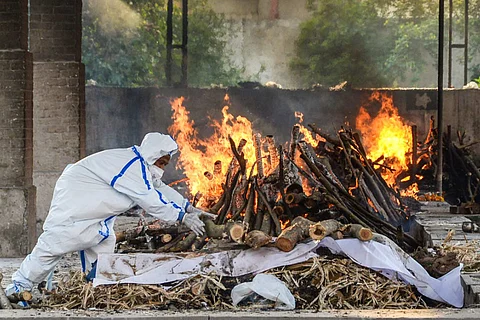

In just over two months, Kerala has added a whopping 18,542 deaths to its total COVID-19 fatalities, which stand at 49,116 as of January 6. That’s 38% of its total deaths. The state, which once prided itself for its COVID-19 management, has the second-highest fatalities in India after Maharashtra. So, what changed?
Since October 22, 2021, Kerala has been including hundreds of backlog deaths every day to its COVID-19 fatalities list. According to the January 6 state health bulletin, a total of 14,763 deaths were declared “as per appeal.” These backlog deaths that have now been accounted for are in deference to a Supreme Court order, directing states to award ex-gratia assistance to victims’ families based on the ICMR and Union government’s guidelines on reporting COVID-19 deaths.
An additional 3,779 deaths due to COVID-19 have also been included in the state’s tally, accounted as “offline period of death reporting.” Kerala had launched a website on June 18 last year, aggregating all deaths due to COVID-19. This is to report and declare such deaths in a decentralized manner at the district level, and allow family members to appeal in case a COVID-19 death has not been included. However, as there were many deaths that have not been accounted for prior to June 18, 2021 — that is, before reporting COVID-19 deaths became an online process — the state allowed families to submit such petitions to the District Medical Officer.
Incidentally, these backlog deaths are expected to increase in the coming days, with over 10,000 appeals pending, as per Kerala’s COVID-19 Death Information System.
These backlogs have significantly pushed up Kerala’s case fatality rate from 0.56% on October 21, 2021 to 0.93% on January 6. Although Kerala has the second-highest fatalities in terms of absolute numbers, its case fatality rate remains below the national average of 1.3%.
“With these additional deaths, the state can no longer claim it has the lowest mortality rate in India. That argument has gone because larger states like Andhra Pradesh, Odisha and even Rajasthan have lower or the same mortality rate as Kerala,” says Rijo John, a health economist and adjunct professor at Rajagiri College of Social Sciences, Kochi. The reconciliation of deaths also means that Kerala’s COVID-19 fatalities may now be a more accurate representation, he says.
#Kerala has reported a total of 18,338 backlog #COVID19 deaths so far during the last 3 mths. This has the overall MR to 0.93% compared to national avg 1.38%.
— Rijo M. John (@RijoMJohn) January 6, 2022
Based on official death counts, Andhra, Telangana, & Odisha have even lesser & Raj with the same MR compared to KL now. pic.twitter.com/AK3amR2m21
Dr Arun NM, an internal medicine specialist and a public health activist, says the huge jump in additional deaths was expected. He attributes political reasons for the reconciliation of COVID-19 deaths, pointing out that it came after the 2021 Assembly Elections and after Health Minister Veena George took over.
So what explains Kerala’s massive undercounting of deaths until October?
Dr Arun provides two reasons. “Earlier, if a patient tested negative for the coronavirus and died later, it wouldn’t be counted as a COVID-19 death. Although the patient was hospitalised in a COVID hospital and had a typical COVID death, it wouldn’t be accounted for because they tested negative. Patients were undergoing antigen tests every two days,” he says. The change in reporting deaths came after the October 4 Supreme Court order, which directed that any person who had died within 30 days of testing positive be treated as a COVID-19 death. This was based on guidelines issued by the Union Health Ministry and the Indian Council of Medical Research (ICMR).
Clerical errors were another reason for the underreporting of deaths. “If there was some discrepancy in the Aadhaar number or date of birth or address of the deceased — basically any clerical error — it was not counted as COVID death,” alleges Dr Arun.
Although these ‘missing’ deaths are now being accounted for, there are still several questions over the numbers. “We have no details on the date of deaths, age, gender, comorbidities, vaccination status. It’s just the number. All of this data should be put in the public domain,” he says.
The backlog deaths, however, are being rationalised in district lists. Dr Arun found a huge jump in the case fatality rate (CFR) in Idukki, Kollam, Kottayam, and Pathanamthitta. Idukki’s case-fatality rate increased by four times from 0.15% on June 16 last year to 0.62% on January 2, while Kollam saw an over three-fold increase between the same period. He, however, observes that a lot of deaths may not have been accounted for in Malappuram, which had a CFR of 0.63% compared to neighbouring districts like Palakkad and Thrissur which were 1.02% and 0.99% respectively on January 2. “I can’t imagine that there is such a big difference in the numbers,” he says.
Many public health and data experts have pointed out that states should not be shamed or discouraged from reporting deaths during the pandemic. Rijo says, “I think it’s good the state has acknowledged the deaths even though it is late. I think that is what every state must do.”